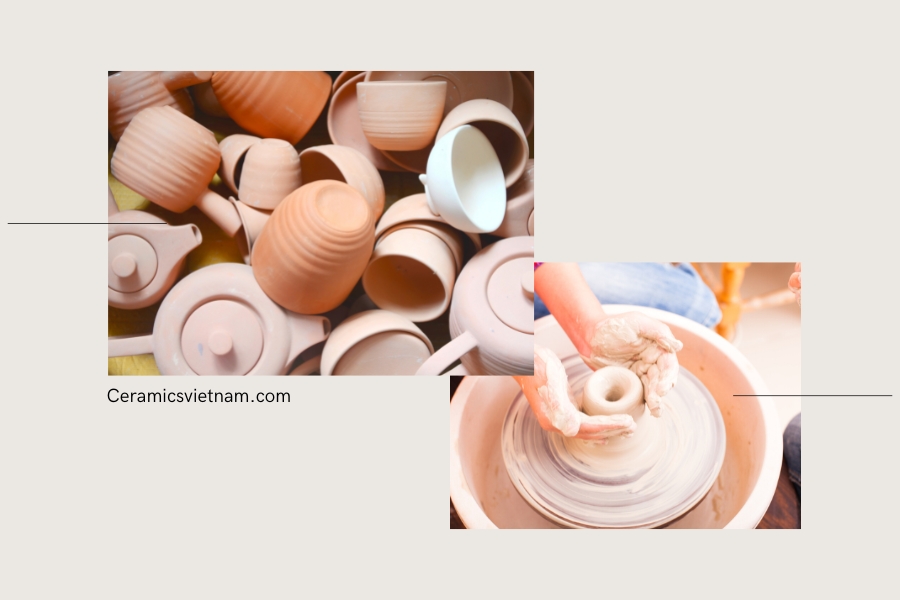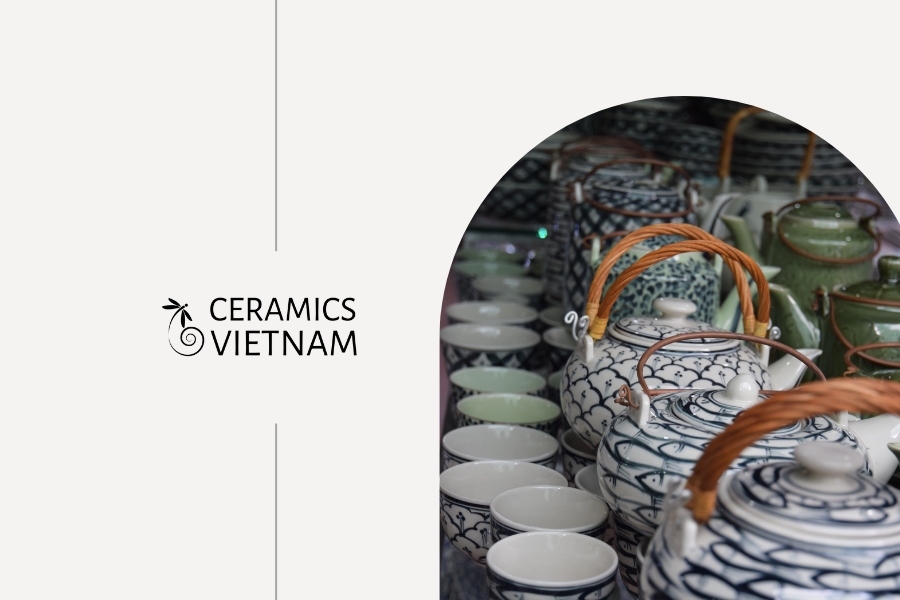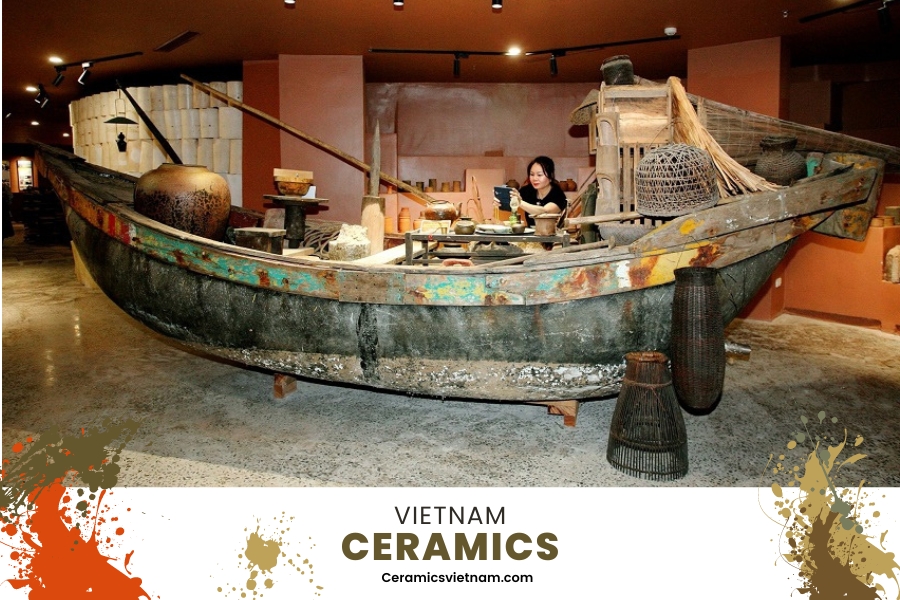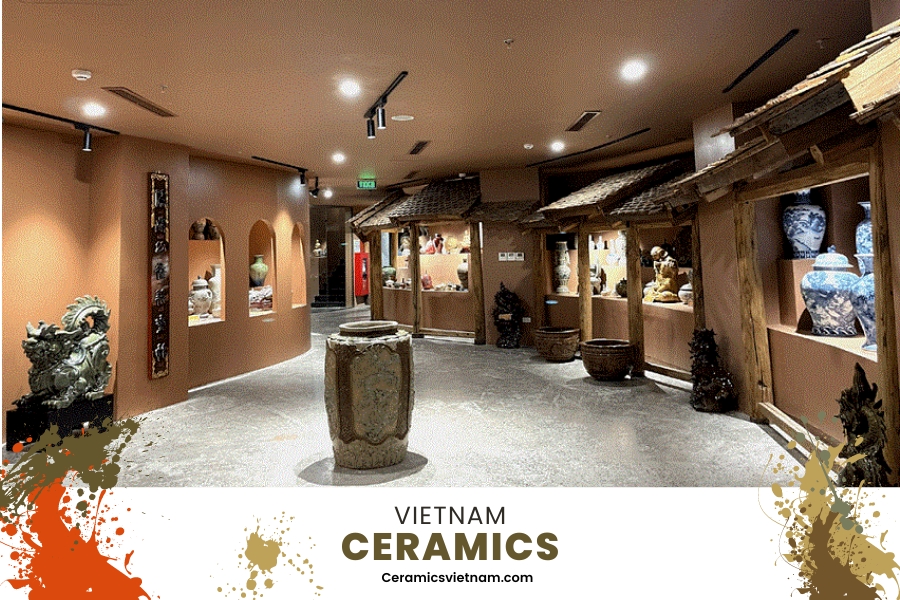
A space to create unique works of art with light.

Visitors to the Ceramics Museum are introduced to the history of the village. In the photo: The area displaying Hứa Vĩnh Kiều.
Reference
Ceramics in Vietnam
Ceramics have been an integral part of Vietnamese art and culture for centuries. Vietnam has a rich tradition of pottery-making, with different regions of the country specializing in unique styles and techniques.
One of the most well-known pottery-making villages in Vietnam is Bat Trang, located in Gia Lam District, Hanoi. Bat Trang ceramics have been recognized for their high quality and unique beauty for over 700 years. The village is known for its use of red-brown clay, which is found in the surrounding hills and is used to create stunning ceramics with intricate designs.
Another region that is renowned for its pottery-making is the Cuu Long River Delta, located in the south of Vietnam. Here, ceramics are created using a unique technique called the “co niu” method, which involves using a coconut shell to shape the clay. The resulting ceramics are often adorned with intricate designs, making them highly sought-after by collectors.
In central Vietnam, the city of Hue is known for its delicate ceramics, which are often decorated with intricate patterns and motifs. Hue ceramics are created using a variety of techniques, including molding, carving, and engraving. The ceramics produced in Hue are often used for decorative purposes and are highly valued for their beauty and intricate designs.

Vietnamese Ceramics and Pottery from the Period of Chinese Domination
In addition to Bat Trang, the Cuu Long River Delta, and Hue, there are many other regions in Vietnam that have a rich tradition of pottery-making. Each region has its unique style and technique, reflecting the diverse cultural heritage of Vietnam.
The importance of ceramics in Vietnamese culture can be seen in the many museums and galleries dedicated to showcasing the country’s rich pottery-making heritage. The Bat Trang Ceramics Museum, for example, is a popular tourist attraction that offers visitors a comprehensive overview of the history and culture of Bat Trang ceramics. The museum features a vast collection of ceramics and artifacts and provides live demonstrations of pottery-making.
Aside from being an essential part of Vietnamese culture, ceramics also play a significant role in the country’s economy. Vietnam is one of the largest exporters of ceramics in the world, with Bat Trang ceramics being particularly popular in international markets.
In conclusion, ceramics have played an integral role in Vietnamese art and culture for centuries. From Bat Trang in the north to the Cuu Long River Delta in the south, each region of Vietnam has its unique style and technique, reflecting the diverse cultural heritage of the country. As a vital part of Vietnam’s cultural and economic landscape, ceramics continue to be a source of pride and inspiration for the Vietnamese people.
Bát Tràng Pottery Village
Bát Tràng is a pottery village located in Gia Lam District, Hanoi, Vietnam. It has been renowned for its ceramics and pottery-making techniques for over 700 years. Bát Tràng ceramics are highly valued for their unique beauty and intricate designs, making them sought after by collectors and art enthusiasts from around the world.
Bát Tràng ceramics are created using locally sourced clay and glazes, which are mixed and molded by hand. The ceramics are then fired in kilns at extremely high temperatures, resulting in durable and long-lasting pieces. The village is known for its use of red-brown clay, which is found in the surrounding hills and gives Bát Tràng ceramics their distinctive color.
The pottery-making techniques used in Bát Tràng have been passed down from generation to generation, with each family specializing in a particular aspect of the process. Some families focus on creating intricate designs and patterns, while others specialize in molding and firing the clay. Despite the specialization, the pottery-making process in Bát Tràng is a communal effort, with families often working together to create beautiful and unique pieces.

Bát Tràng Pottery Village
In addition to its beautiful ceramics, Bát Tràng is also a popular tourist destination. Visitors can explore the village’s narrow streets and alleys, which are lined with workshops and galleries showcasing the village’s rich pottery-making heritage. Many workshops offer pottery-making classes, allowing visitors to create their own unique pieces under the guidance of skilled artisans.
The Bát Tràng Ceramics Museum is another popular attraction in the village. The museum features a vast collection of ceramics and artifacts, providing visitors with a comprehensive overview of the history and culture of Bát Tràng ceramics. The museum also offers live demonstrations of pottery-making, allowing visitors to witness the intricate process of creating beautiful ceramics firsthand.
Bát Tràng ceramics have not only played an essential role in Vietnamese culture but have also been a significant contributor to the country’s economy. Vietnam is one of the largest exporters of ceramics in the world, with Bát Tràng ceramics being particularly popular in international markets. The ceramics industry in Bát Tràng provides employment to thousands of people, with many families making a living through pottery-making.
In conclusion, Bát Tràng is a pottery village that has been renowned for its ceramics and pottery-making techniques for centuries. Its unique beauty and intricate designs have made it a sought-after destination for collectors and art enthusiasts from around the world. As a popular tourist destination and an essential contributor to the Vietnamese economy, Bát Tràng is a living testament to the rich cultural heritage of Vietnam.

Bát Tràng Pottery Village
Vietnam Association of Craft Villages
The Vietnam Association of Craft Villages (VACV) is an organization dedicated to promoting and preserving traditional craft villages in Vietnam. The association was established in 2006 and is headquartered in Hanoi, Vietnam.
The VACV plays an essential role in supporting traditional craft villages by providing them with access to resources and expertise. The organization works closely with local governments, academic institutions, and businesses to promote the development of craft villages and to raise awareness of their cultural and economic significance.
One of the primary goals of the VACV is to preserve traditional crafts and techniques that have been passed down from generation to generation. The organization offers training and educational programs to artisans, helping them to improve their skills and develop new techniques. This helps to ensure that traditional crafts are passed down to future generations and continue to be a source of pride and inspiration for the Vietnamese people.

Vietnam Association of Craft Villages
The VACV also works to promote the economic development of craft villages. The organization helps artisans to connect with markets, both within Vietnam and internationally, providing them with access to new customers and opportunities. By promoting the economic development of craft villages, the VACV helps to create jobs and stimulate economic growth in rural areas.
Another important role of the VACV is to raise awareness of the cultural and historical significance of traditional crafts. The organization hosts exhibitions, workshops, and other events that showcase the beauty and complexity of traditional crafts, helping to educate the public about their cultural heritage. This helps to foster a sense of pride and appreciation for traditional crafts among the Vietnamese people and promotes the preservation of traditional crafts for future generations.
In conclusion, the Vietnam Association of Craft Villages plays a crucial role in promoting and preserving traditional crafts in Vietnam. By providing resources and expertise, promoting economic development, and raising awareness of the cultural and historical significance of traditional crafts, the VACV helps to ensure that these cherished traditions continue to thrive and inspire future generations.
Vietnam Quintessential Handicraft
Vietnam has a rich tradition of handicrafts, with different regions of the country specializing in unique styles and techniques. From pottery and ceramics to weaving and embroidery, Vietnamese handicrafts are renowned for their intricate designs and exquisite beauty.
The Vietnam Quintessential Handicraft, also known as the Vietnam Craft Village Association, is an organization dedicated to promoting and preserving traditional handicrafts in Vietnam. The association was established in 2007 and is headquartered in Hanoi, Vietnam.
The Vietnam Quintessential Handicraft plays an essential role in supporting traditional craft villages by providing them with access to resources and expertise. The organization works closely with local governments, academic institutions, and businesses to promote the development of craft villages and to raise awareness of their cultural and economic significance.

Ancient Vietnamese Pottery
One of the primary goals of the Vietnam Quintessential Handicraft is to preserve traditional crafts and techniques that have been passed down from generation to generation. The organization offers training and educational programs to artisans, helping them to improve their skills and develop new techniques. This helps to ensure that traditional crafts are passed down to future generations and continue to be a source of pride and inspiration for the Vietnamese people.
The Vietnam Quintessential Handicraft also works to promote the economic development of craft villages. The organization helps artisans to connect with markets, both within Vietnam and internationally, providing them with access to new customers and opportunities. By promoting the economic development of craft villages, the Vietnam Quintessential Handicraft helps to create jobs and stimulate economic growth in rural areas.
In addition to promoting traditional crafts and supporting economic development, the Vietnam Quintessential Handicraft also works to raise awareness of the cultural and historical significance of handicrafts. The organization hosts exhibitions, workshops, and other events that showcase the beauty and complexity of traditional crafts, helping to educate the public about their cultural heritage. This helps to foster a sense of pride and appreciation for traditional crafts among the Vietnamese people and promotes the preservation of traditional crafts for future generations.
One of the most well-known handicraft villages in Vietnam is Bat Trang, located in Gia Lam District, Hanoi. Bat Trang ceramics have been recognized for their high quality and unique beauty for over 700 years. The village is known for its use of red-brown clay, which is found in the surrounding hills and is used to create stunning ceramics with intricate designs.
The Bat Trang Ceramics Museum, which is also supported by the Vietnam Quintessential Handicraft, is a popular tourist attraction that offers visitors a comprehensive overview of the history and culture of Bat Trang ceramics. The museum features a vast collection of ceramics and artifacts and provides live demonstrations of pottery-making.

Vietnamese Ceramics
Another region that is renowned for its handicrafts is Hoi An, located in Quang Nam Province. Hoi An is known for its delicate silk lanterns, which are created using traditional techniques and feature intricate designs and patterns. The town is also famous for its embroidery, which is created using a variety of techniques and is known for its intricate and detailed designs.
In the highlands of Vietnam, the Hmong people are known for their intricate weaving techniques, creating stunning textiles with vibrant colors and intricate patterns. The Vietnam Quintessential Handicraft supports Hmong artisans by providing them with training and resources to improve their skills and promote their work.
In addition to these well-known handicrafts, there are many other regions in Vietnam that have a rich tradition of handicrafts. Each region has its unique style and technique, reflecting the diverse cultural heritage of Vietnam.
The importance of handicrafts in Vietnamese culture can be seen in the many museums and galleries dedicated to showcasing the country’s rich handicraft heritage. These institutions play an essential role in preserving traditional crafts and educating the public about their cultural and historical significance.
In conclusion, the Vietnam Quintessential Handicraft plays a crucial role in promoting and preserving traditional handicrafts in Vietnam. By providing resources and expertise, promoting economic development, and raising awareness of the cultural and historical significance of traditional crafts, the Vietnam Quintessential Handicraft helps to ensure that these cherished traditions continue to thrive and inspire future generations.
Through the work of organizations like the Vietnam Quintessential Handicraft, traditional handicrafts in Vietnam continue to be a source of pride and inspiration for the Vietnamese people. These handicrafts are not only a vital part of Vietnam’s cultural heritage but also contribute significantly to the country’s economy. The handicraft industry in Vietnam provides employment to thousands of people, particularly in rural areas, and helps to stimulate economic growth and development.
For tourists visiting Vietnam, exploring the country’s handicraft villages and museums is an excellent way to learn about Vietnamese culture and history. Visitors can witness traditional crafts being created firsthand, meet skilled artisans, and purchase unique and beautiful handicrafts to take home as souvenirs.

Vietnamese Ceramics and Pottery from the Period of Chinese Domination
In summary, the Vietnam Quintessential Handicraft plays an essential role in promoting and preserving traditional handicrafts in Vietnam. Through its work, the organization helps to ensure that these cherished traditions continue to thrive and inspire future generations. Handicrafts in Vietnam are not only a source of pride and inspiration but also an essential contributor to the country’s cultural and economic landscape. By supporting and promoting traditional handicrafts, the Vietnam Quintessential Handicraft helps to preserve and promote these cherished traditions for future generations to enjoy.



















Leave a reply